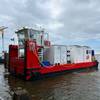ExxonMobil has introduced a program to optimize cylinder oil feed rates in
low-speed (crosshead) diesel engines, the most common power source used for
marine propulsion. The Feed Rate Optimization program is designed to help
minimize operating expenses by analyzing scrapedown oil as a way to detect
changes in the condition of an engine¹s cylinders.
The program, which is designed to help customers find a balance between the
cost of cylinder oil and the expense of wear-related cylinder maintenance,
analyzes scrapedown oil collected from the engine¹s scavenge space, a
technique pioneered by ExxonMobil. It provides comprehensive laboratory
testing and analysis of the oil sample, and offers onboard testing tools
that enable ship¹s engineers to quickly detect substantive changes in
cylinder condition.
”We have introduced this program to make it easier for ship operators to
respond to recommendations from engine manufacturers to adjust feed rates,”
says Mark Andreotta, vice president, ExxonMobil Marine & Aviation
Lubricants. “At a time when new severe engine designs are operating in
high-stress environments, we have developed a way to provide our customers
with the data and knowledge they need to safely optimize cylinder oil feed
rates and also to take preventive measures to reduce wear-related
maintenance and operating costs. This initiative is another example of our
leadership in the marine industry.”
The new program features:
. Signum Oil Analysis. ExxonMobil has extended its existing Signum Oil
Analysis program, which can help forecast potential mechanical problems
before they occur, to include scrapedown testing. This extensive laboratory
analysis provides insight into engine wear via the condition of a vessel¹s
scrapedown oil.
. Onboard testing. Onboard testing tools include a proprietary Mobilgard
Scrapedown Analyzer, a portable unit that enables a ship¹s engineer to
quickly analyze the current wear rate of each cylinder. For customers who
do not want to wait for a comprehensive lab report, onboard testing provides
real-time readouts on the oil¹s most important properties relative to the
engine's operating condition.
. Quality oil. ExxonMobil recommends Mobilgard 570, a cylinder oil
formulated at an optimized viscosity level with high quality base oil to
provide excellent thermal and oxidation stability, and protection against
engine deposit and wear. It is proven to provide low-speed, two-cycle
crosshead diesel engines with these performance features even as lower feed
rates are adopted.
The new Feed Rate Optimization program was developed with the support of the
major engine manufacturers, including MAN B&W and Wärtsilä.
”Changes in cylinder wear due to engine operation, ambient conditions and
fuel sulfur levels can be detected as they are occurring, particularly if
onboard sample analysis is employed,² says Kjeld E. Aabo, senior manager
engineering services, MAN B&W Diesel A/S. ³Advanced warning of cylinder
condition, as seen through scrapedown oil analysis results, allows the
operator to optimize feed rates while ensuring optimum engine performance.”
Subscribe for
Maritime Reporter E-News
Maritime Reporter E-News is the maritime industry's largest circulation and most authoritative ENews Service, delivered to your Email five times per week










